The fall foliage I uploaded yesterday leaned strongly towards reds. Yet, sometimes yellow can make an equal statement. Especially a yellow intense enough to literally drag me down the street to investigate.
Meet the Japanese katsura tree (Cercidiphyllum japonicum), a tree that should be planted more often in Toronto. This picture is just as it came out of the camera, with no colour boost. Not one little bit.
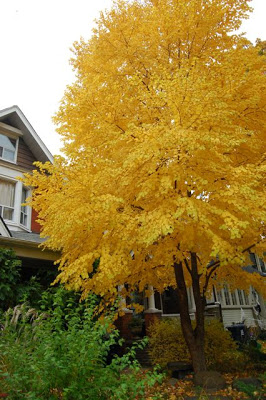 And here’s how it looks from afar. Isn’t that clear, rich yellow something else? On an overcast afternoon like today, this was sunshine on a stick; a golden pool amid the darker foliage all along the street.
And here’s how it looks from afar. Isn’t that clear, rich yellow something else? On an overcast afternoon like today, this was sunshine on a stick; a golden pool amid the darker foliage all along the street.I read recently that katsura’s autumn leaves give off a scent like candy floss. That would be very pleasant indeed, but my nose didn’t detect any today.
What says this is a katsura? Mostly, the small, simple oops, I meant smooth-edged [I knew as soon as I hit Publish that “simple” didn’t mean “smooth-edged.” Simple leaves are simply not compound.], heart-shaped leaves.
The name Cercidiphyllum means roughly “with leaves like a Cercis” or redbud. On this specimen, the shape is enhanced by a feathered pencilling of dark green at the edges. I wonder if that happens every year?
Katsuras tend to have a vase-shaped branching habit you can begin to see in the tree above, but which can be more pronounced and multi-stemmed.
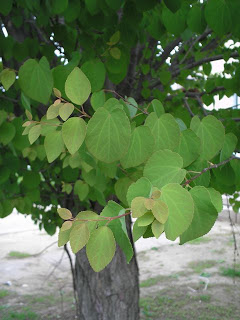 Closer to home, this katsura at right in a more exposed position was photographed in May. Its foliage is virtually gone right now. Squint carefully at the picture’s upper right corner, and you can almost make out the upward branching pattern.
Closer to home, this katsura at right in a more exposed position was photographed in May. Its foliage is virtually gone right now. Squint carefully at the picture’s upper right corner, and you can almost make out the upward branching pattern.Katsuras are among the choices available through Toronto’s street tree program, which also includes a number of local and North American native trees. This tree is a well-behaved guest, however, and is deserving of consideration.
It’s clear some of the local wildlife concurs.

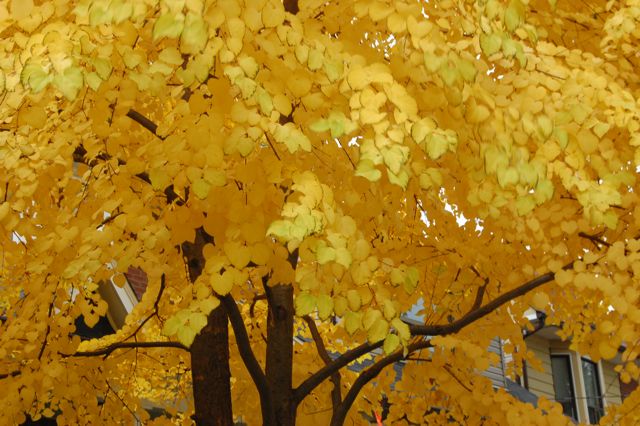

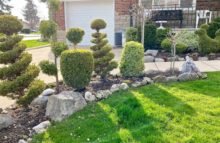
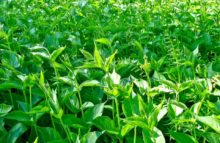

18 comments
It's a lovely tree isn't it? Sorry you didn't detect any scent. It's meant to be more noticeable after a frost, so you might find it later. I also found it was more noticeable with the fallen leaves – perhaps the frost had got to these more than the leaves on the trees?
Have a great weekend!
I have always read about the smell, too. I do love cotton candy.
What could be better than Cercis like leaves? My favourite is Disanthus cercidiphyllum. A witchhazel relative with fabulous Fall colour.
I remember seeing Disanthus in your garden, Barry. Didn't realize how wonderful the fall colour was.
Just looked it up online, and found this link to a pic from the UBC Botanical Garden. It won't be clickable, but I encourage everyone to paste it into their browser. This is one jewelbox of a shrub:
http://www.ubcbotanicalgarden.org/potd/disanthus_cercidifolius.jpg
It's a new tree for me. It's very pretty!
It's gorgeous. Reading this and the post above prompts me to ask for tree advice. We've got a space in the back that would benefit from a tree (I think) and planting a tree would begin, slowly, to compensate for a tree we will lose soon. But in fact there isn't a ton of space, so we really do need something without a huge wingspan. I was thinking of one of the smaller serviceberry trees. Now perhaps the katsura. Any other suggestions. And will next weekend be to late to snuggle it into the ground?
thanks!
Rose
Hi, Rose,
You don't mention your soil type, sun/shade, moisture level or zone, so this will be very, very general advice. However, if you're considering a serviceberry for your garden due to space, the katsura wouldn't be a likely substitute, as it is significantly larger. If you click that link embedded in the first paragraph, you'll get more info on the katsura, which will grow up to 60' tall and 40' across at maturity (in ideal conditions, of course).
There are some lovely smaller trees you might consider, including the Cercis or redbud, which is so named for the small, pink or white, pealike blooms that grow right on the branches before the leaves come out. One of the newer varieties of redbud is 'Forest Pansy' which has rich purple leaves in that heart shape all the summer through.
It's hard to beat a serviceberry for multi-season interest in a small garden, though. The spring flowers are like white clouds, and the berries are good to eat (a bit like blueberries) if you can get them before the birds do. There are also numerous varieties of serviceberry to look out for, each with different characteristics. For instance, one called, I believe, 'Ballerina' is more columnar (tall and narrow). Others have been selected for their stronger red fall foliage.
Choosing trees is fun. I'm in that stage of my garden reno now, which is why trees have been on my mind and blog so frequently of late.
Have fun, and good luck.
Oops, I mean the link in the 2nd paragraph. Pays to read my own blog, eh?
Thanks Helen! You're right about the katsura -and I should have followed the links! I worry about the redbud just because there's one in the yard behind us that is deeply, deeply unwell. Poor thing. But we have amended clay soil and the tree would have eastern exposure, with some protection (thanks to fences) from wind, and sun to very partial shade. That shade will become less partial over time when one of the existing trees goes and when a neighbor's manitoba maple finally falls down completely.
The Ballerina is exactly the serviceberry that caught my eye – it seems so elegant and tidy and would suit us well. I think. And it would attract birds, which is always nice. Do you think there's still time to sneak one in the ground (provided Humber still has them in stock?)
Thanks again! Your advice is always so fabulous!
Rose
Fall is an excellent time to plant perennials, trees and shrubs. Get it in there soon, though…
Make sure it has some water before freeze-up, then mulch the soil, not too close to the trunk, once the ground freezes. Mulching before freeze might (might) encourage it to put out new growth if we get another warm spell, and that would be too tender to weather the winter.
Thanks Helen! I'll report next spring.
R
It's not too hard to figure out why these aren't planted more—they're incredibly messy trees. Their seed pods, leaves, and flowers are worse than walnuts or Norway Maples.
Nick, Are you sure you're talking about the katsura tree and not the Catalpa (which can certainly be messy with its flowers and pods)?
The katsura is dioecious (male and female on different trees) and its flowers are described as insignificant. The seed pods are also described as small, and unless there is a male around to fertilize them, they wouldn't mature. The leaves are fairly small, too — much smaller than Norway maples and catalpas. Looking around on the internet, I can't find any other mention of the katsura being messy. Can you point me to a reference? Here's something, for example, from the University of Arkansas Dept. of Agriculture.
http://www.arhomeandgarden.org/plantoftheweek/articles/katsura_tree_11-2-07.htm
A beautiful specimen…so vibrant. I am in awe of all those golden leaves. No wonder you chose this one to post!
Help! The city of Toronto is replacing our Maple with a Japanese Katsura Red-Bud Tree (of which I am unfamiliar) and having spent a fortune on retaining walls and landscaping, I am concerned about how this tree is going to impact our current and ongoing landscape plans. Can you direct me to a site that offers specific details about this particular species of Japanese Katsura. Many thanks.
Hi, Angela, I've never heard of a Katsura redbud — but the botanical genus name for Katsura is Cercidiphyllum which means "with leaves like Cercis or redbud. So perhaps the common name you were given is a mistaken version of that.
I can imagine few things more sickly sweet to have to smell than cotton candy – just the smell is nausea inducing for some of us! Why should we be introducing foreign trees to our cityscape – a balanced mix of good North American native species is both suitable and colourful. Let's honour our own native species!
I'm chuckling at your description. Actually, the cotton-candy scent is fairly subtle. I hear you on the subject of natives, but I also believe in plant diversity. Sugar maples and red maples, which I love, don't stand up to city pollution or foot traffic. Ash trees have wonderful fall colour, but are being decimated by emerald ash borer. I'm happy to see more underused North American natives on our streets such as sweet gum (Liquidambar) and tulip tree (Liriodendron), and the new hybrid Freeman maple. But a few Katsuras here and there are okay by me.